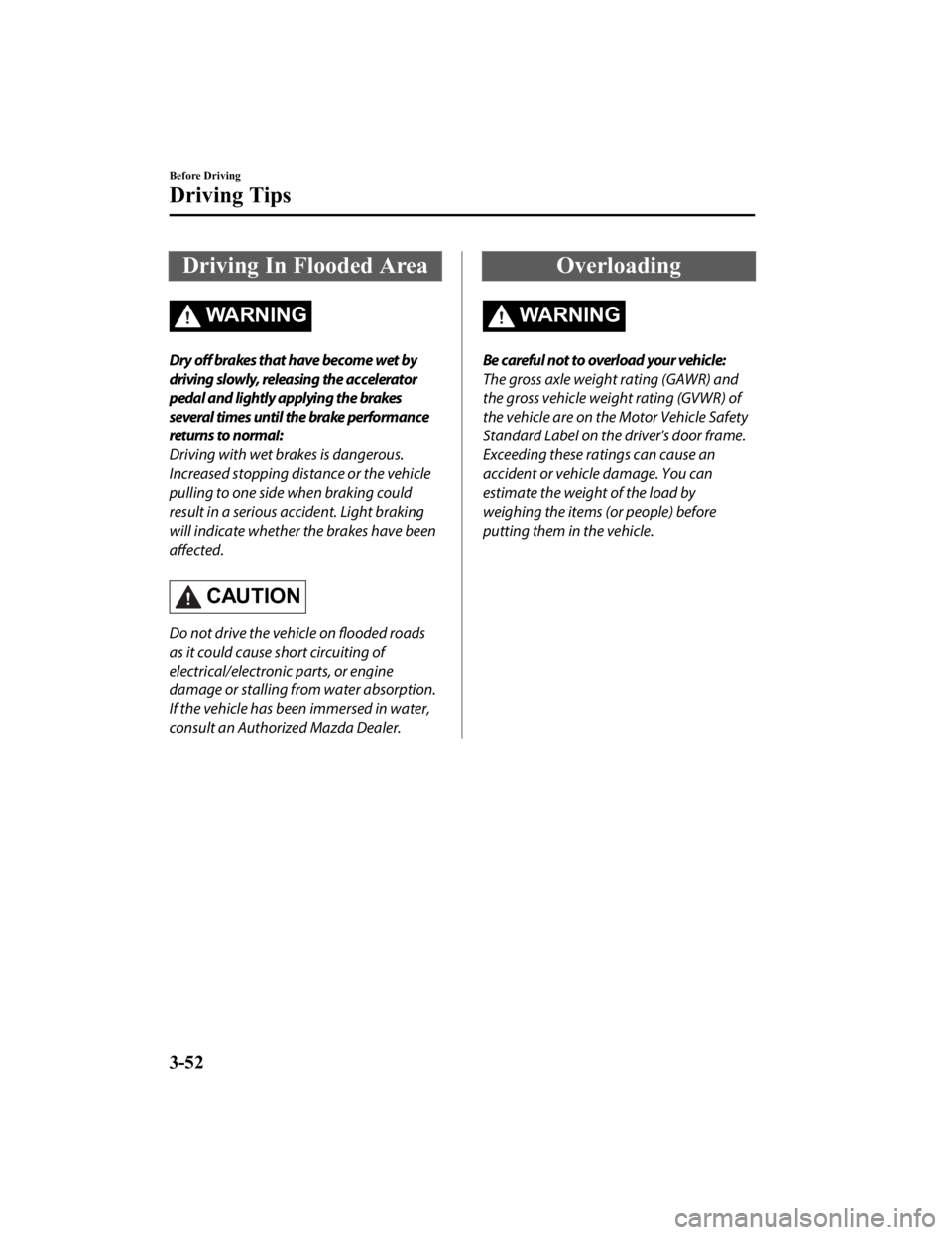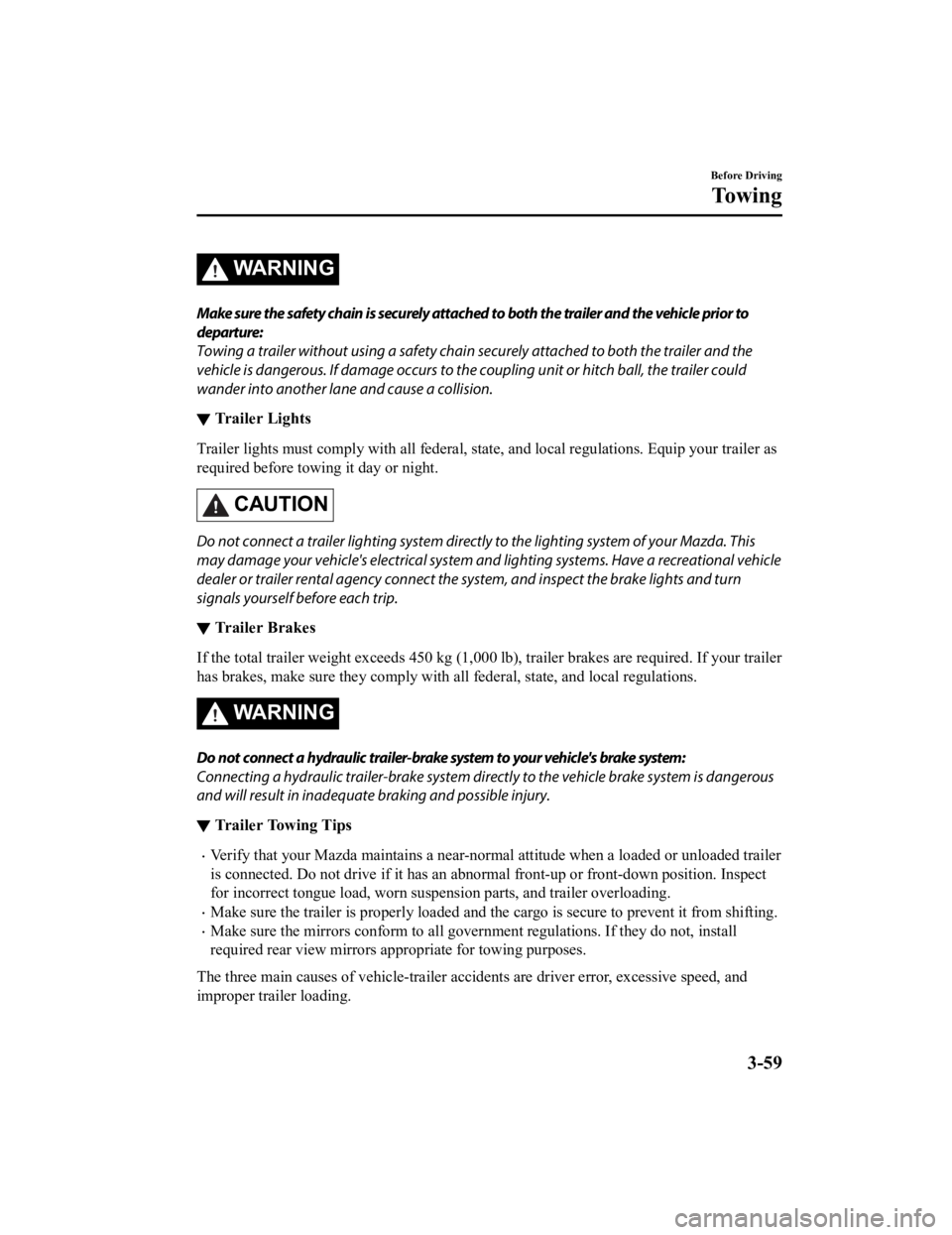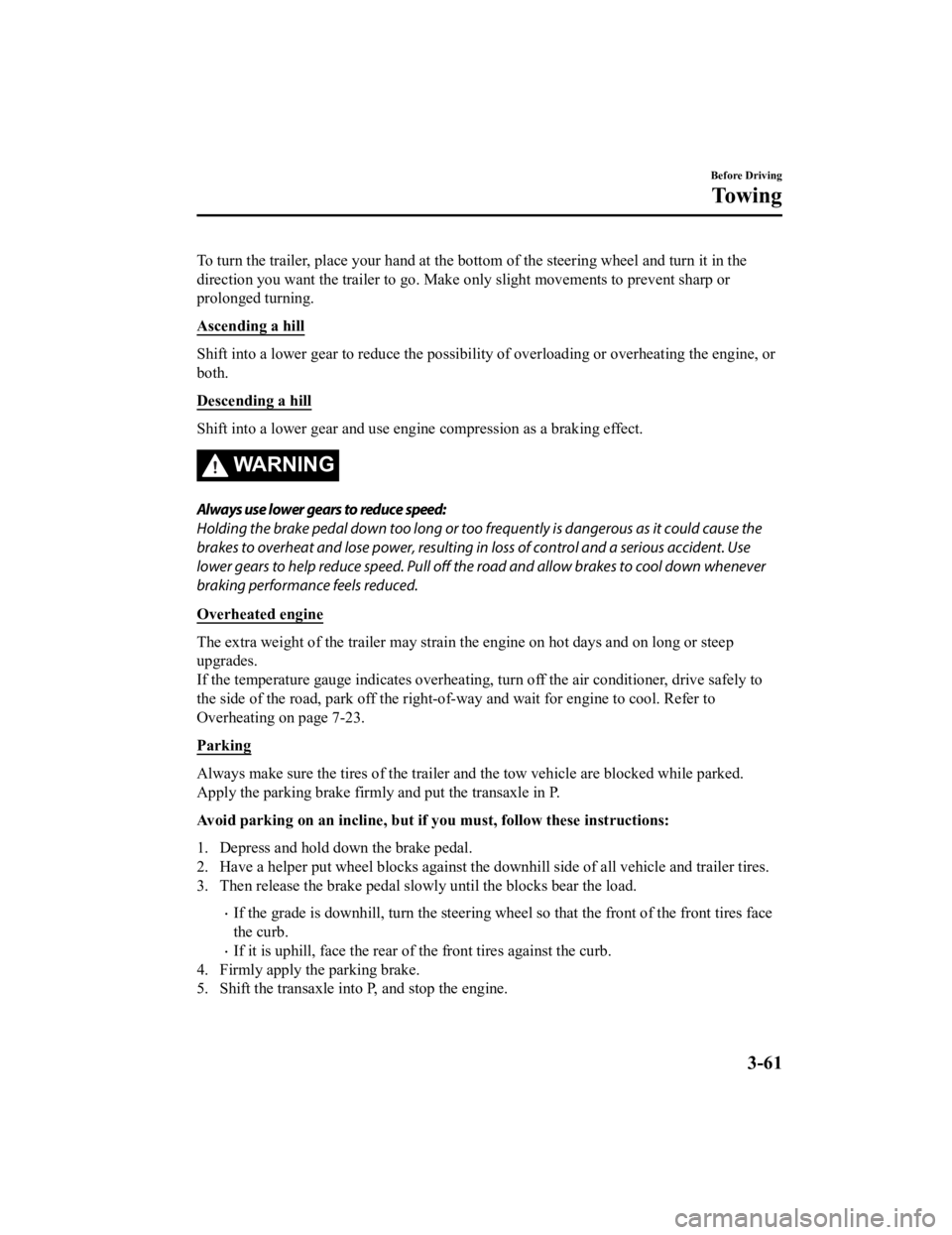light MAZDA CX9 2023 Repair Manual
[x] Cancel search | Manufacturer: MAZDA, Model Year: 2023, Model line: CX9, Model: MAZDA CX9 2023Pages: 739, PDF Size: 11.69 MB
Page 153 of 739

Driving In Flooded Area
WA R N I N G
Dry off brakes that have become wet by
driving slowly, releasing the accelerator
pedal and lightly applying the brakes
several times until the brake performance
returns to normal:
Driving with wet brakes is dangerous.
Increased stopping distance or the vehicle
pulling to one side when braking could
result in a serious accident. Light braking
will indicate whether the brakes have been
affected.
CAUTION
Do not drive the vehicle on flooded roads
as it could cause short circuiting of
electrical/electronic parts, or engine
damage or stalling from water absorption.
If the vehicle has been immersed in water,
consult an Authorized Mazda Dealer.
Overloading
WA R N I N G
Be careful not to overload your vehicle:
The gross axle weight rating (GAWR) and
the gross vehicle weight rating (GVWR) of
the vehicle are on the Motor Vehicle Safety
Standard Label on the driver's door frame.
Exceeding these ratings can cause an
accident or vehicle damage. You can
estimate the weight of the load by
weighing the items (or people) before
putting them in the vehicle.
Before Driving
Driving Tips
3-52
CX-9_8LJ2-EA-22H_Edition1_old2022-6-9 13:33:08
Page 160 of 739

WA R N I N G
Make sure the safety chain is securely attached to both the trailer and the vehicle prior to
departure:
Towing a trailer without using a safety chain securely attached to both the trailer and the
vehicle is dangerous. If damage occurs to the coupling unit or hitch ball, the trailer could
wander into another lane and cause a collision.
â–¼ Trailer Lights
Trailer lights must comply with a
ll federal, state, and local regulations. Equip your trailer as
required before towing it day or night.
CAUTION
Do not connect a trailer lighting system directly to the lighting system of your Mazda. This
may damage your vehicle's electrical system an d lighting systems. Have a recreational vehicle
dealer or trailer rental agency connect the system, and inspect the brake lights and turn
signals yourself before each trip.
â–¼ Trailer Brakes
If the total trailer weight exc
eeds 450 kg (1,000 lb), trailer brakes are required. If your trailer
has brakes, make sure they compl y with all federal, state, and local regulations.
WA R N I N G
Do not connect a hydraulic trailer-brake system to your vehicle's brake system:
Connecting a hydraulic trailer-brake system direc tly to the vehicle brake system is dangerous
and will result in inadequate braking and possible injury.
â–¼ Trailer Towing Tips
ï‚·Verify that your Mazda
maintains a near-normal attitude when a loaded or unloaded trailer
is connected. Do not d rive if it has an abnormal front-up or fr ont-down position. Inspect
for incorrect tongue load, worn suspension parts, and trailer o verloading.
ï‚·Make sure the trailer is properly loaded and the cargo is secur e to prevent it from shifting.
ï‚·Make sure the mirrors conform to all government regulations. If they do not, install
required rear view mirrors appr opriate for towing purposes.
The three main causes of vehicle-trailer accidents are driver e rror, excessive speed, and
improper trailer loading.
Before Driving
To w i n g
3-59
CX-9_8LJ2-EA-22H_Edition1_old 2022-6-9 13:33:08
Page 161 of 739

Before driving
ï‚·Have your cooling and braking system checked by an Authorized M azda Dealer.
ï‚·Before starting out, inspect the operation of all vehicle and t railer lights and all
vehicle-to-trailer connections. Stop and re-inspect all lights and connections after driving
a short distance.
Driving
ï‚·Your Mazda will handle differentl y with a trailer in tow, so practice turning, backing, and
stopping in a traffic-free area.
ï‚·Take time to get accustomed to the extra weight and length.
ï‚·Allow more room between your vehicle and the one in front becau se braking distance
increases with a trailer. For each 16 km/h (10 mph) of speed, a llow at least one vehicle
and trailer length between your M azda and the vehicle ahead.
ï‚·Avoid jerky starts or sudden acceleration.
ï‚·Avoid sudden braking. It may cause loss of control and result i n jackknifing, especially so
on wet or slippery roads.
ï‚·Shift the selector lever to the D position when towing a trailer in hilly terrain or when
heavily loaded.
The D position will allow operating the vehicle without frequen t shifting.
Lane changes and turning
Avoid quick lane changes, sudden turns, and tight turns. Slow d own before turning to avoid
the need of sudden braking.
A turning trailer will make a tighter arc than the tow vehicle. Compensate with turns that are
larger than normal.
Passing
Plan well ahead to pass other v ehicles, and provide plenty of r oom before changing lanes.
Crosswinds from passing vehicles, especially larger ones, and t he effects of rough roads will
affect handling.
If swaying occurs, firmly grip the steering wheel and reduce sp eed immediately, but
gradually.
Steer straight ahead. If no extr eme correction of steering or b raking is made, the
combination of less speed and firm steering will result in stab ility.
Backing up
Backing a vehicle with a traile r requires practice and patience . Back slowly, and have a
helper outside at the rear of th e trailer to reduce the risk of an accident.
Before Driving
To w i n g
3-60
CX-9_8LJ2-EA-22H_Edition1_old 2022-6-9 13:33:08
Page 162 of 739

To turn the trailer, place your hand at the bottom of the steering wheel and turn it in the
direction you want the trailer to go. Make only slight movements to prevent sharp or
prolonged turning.
Ascending a hill
Shift into a lower gear to reduce the possibility of overloadin g or overheating the engine, or
both.
Descending a hill
Shift into a lower gear and use engine compression as a braking effect.
WA R N I N G
Always use lower gears to reduce speed:
Holding the brake pedal down too long or too frequently is dangerous as it could cause the
brakes to overheat and lose power, resulting in loss of control and a serious accident. Use
lower gears to help reduce speed . Pull off the road and allow brakes to cool down whenever
braking performance feels reduced.
Overheated engine
The extra weight of the trailer may strain the engine on hot da ys and on long or steep
upgrades.
If the temperature gauge indicates overheating, turn off the ai r conditioner, drive safely to
the side of the road, park off t he right-of-way and wait for en gine to cool. Refer to
Overheating on page 7-23.
Parking
Always make sure the tires of the trailer and the tow vehicle a re blocked while parked.
Apply the parking brake firmly and put the transaxle in P.
Avoid parking on an incline, but if you must, follow these instructions:
1. Depress and hold down the brake pedal.
2. Have a helper put wheel blocks against the downhill side of a ll vehicle and trailer tires.
3. Then release the brake pedal slowly until the blocks bear the load.
ï‚·If the grade is downhill, turn the steering wheel so that the front of the front tires face
the curb.
ï‚·If it is uphill, face the rear of the front tires against the curb.
4. Firmly apply th e parking brake.
5. Shift the transaxle into P, and stop the engine.
Before Driving
To w i n g
3-61
CX-9_8LJ2-EA-22H_Edition1_old 2022-6-9 13:33:08
Page 166 of 739

4When Driving
Information concerning safer driving and stopping.
Start/Stop Engine.............................. 4-4 Ignition Switch........ ..................... 4-4
Starting the Engine....................... 4-5
Turning the Engine Off...............4-10
Instrument Cluster and Display ............
........................................................... 4-11 Instrument Cluster and
Display........................................ 4-11
Instrument Cluster (Type A)....... 4-12
Instrument Cluster (Type B)....... 4-29
Instrument Cluster (Type C)....... 4-45
Active Driving Display
*............. 4-57
Automatic Transaxle....................... 4-59 Automatic Transaxle
Controls...................................... 4-59
Shift-Lock System...................... 4-60
Transaxle Ranges........................4-60
Manual Shift Mode..................... 4-62
Direct Mode
*.............................. 4-69
Driving Tips................................4-70
Switches and Controls..................... 4-71 Lighting Control......................... 4-71
Fog Lights
*................................. 4-77
Turn and Lane-Change
Signals........................................ 4-78
Windshield Wipers and
Washer........................................ 4-79
Rear Window Wiper and
Washer........................................ 4-82
Rear Window Defogg er.............. 4-83
Horn............................................ 4-84
Hazard Warning Flasher............. 4-85
HomeLink Wireless Control System
(Type A)
*.................................... 4-85
HomeLink Wireless Control System
(Type B)
*.................................... 4-89
Brake................................................ 4-94 Brake System.............................. 4-94
AUTOHOLD.............................. 4-98
Hill Launch Assist (HLA)........ 4-102
ABS/TCS/DSC/Trailer Stability
Control (TSC)/Off-Road Traction
Assist............................................... 4-104 Antilock Brake System
(ABS)........................................4-104
Traction Control System
(TCS)........................................ 4-105
Dynamic Stability Control
(DSC)........................................4-107
Trailer Stability Control
(TSC)........................................ 4-108
Off-Road Traction Assist
*........ 4-109
Drive Selection............................... 4-111 Drive Selection......................... 4-111
i-ACTIV AWD............................... 4-113 i-ACTIV AWD Operation
*....... 4-113
Power Steering............................... 4-115 Power Steering..........................4-115
*Some models.4-1
CX-9_8LJ2-EA-22H_Edition1_old 2022-6-9 13:33:08
Page 167 of 739

i-ACTIVSENSE............................. 4-116i-ACTIVSENSE
*...................... 4-116
Adaptive Front Lighting System
(AFS)
*.......................................4-119
High Beam Control System
(HBC)
*......................................4-120
Blind Spot Monitoring (BSM)
*.........
.................................................. 4-123
Traffic Sign Recognition System
(TSR)
*...................................... 4-129
Distance Recognition Support
System (DRSS)
*....................... 4-135
Driver Attenti on Alert (DAA)
*..........
.................................................. 4-139
Rear Cross Traffic Alert (RCTA)
*.....
.................................................. 4-141
Mazda Radar Cruise Control with
Stop & Go function (MRCC with
Stop & Go function)
*............... 4-145
Lane-keep Assist System (LAS) &
Lane Departure Warning System
(LDWS)
*.................................. 4-160
Advanced Smart City Brake Support
(Advanced SCBS)
*...................4-171
Smart City Brake Support [Forward]
(SCBS F)
*.................................4-174
Smart City Brake Support [Reverse]
(SCBS R)
*................................ 4-178
Smart Brake Support (SBS)
*.... 4-182
360° View Monitor (Mazda Connect
(Type A))
*................................ 4-184
360° View Monitor (Mazda Connect
(Type B))
*................................. 4-211
Forward Sensing Camera (FSC)
*......
.................................................. 4-239
Radar Sensor (Front)*.............. 4-244
Radar Sensors (Rear)
*.............. 4-247
Ultrasonic Sensor (Rear)
*.........4-249
Front Camera/Side Cameras/Rear
Camera
*.................................... 4-250
Cruise Control............................... 4-251 Cruise Control
*.........................4-251
Tire Pressure Monitoring
System.............................................4-256 Tire Pressure Monitoring
System...................................... 4-256
Rear View Monitor (Mazda Connect
(Type A))........................................ 4-260 Rear View Monitor (Mazda Connect
(Type A))
*................................ 4-260
Rear View Monitor (Mazda Connect
(Type B)).........................................4-268 Rear View Monitor (Mazda Connect
(Type B))
*.................................4-268
Parking Sensor System (Mazda
Connect (Type A))......................... 4-276 Parking Sensor System (Mazda
Connect (Type A))
*.................. 4-276
Parking Sensor System (Mazda
Connect (Type B))......................... 4-287 Parking Sensor System (Mazda
Connect (Type B))
*.................. 4-287
4-2*Some models.
CX-9_8LJ2-EA-22H_Edition1_old 2022-6-9 13:33:08
Page 169 of 739

Ignition Switch
â–¼Push Button Start Positions
The system operates only when the key is
within operational range.
Each time the push button start is pressed,
the ignition switches
in the order of off,
ACC, and ON. Pressing the push button
start again from ON switches the ignition
off.
Indicator light
NOTE
ï‚·The engine starts by pressing the push
button start while depressing the brake
pedal. To switch the ignition position,
press the push button start without
depressing the pedal.
ï‚·Do not leave the ignition switched ON
while the engine is not running. Doing
so could result in the battery going
dead. If the selector lever is in the P
position, and the ignition is in ACC, the
ignition switches off automatically after
about 25 minutes.
Off
The power supply to electrical devices
turns off and the push button start
indicator light (amber) also turns off.
WA R N I N G
Before leaving the driver's seat, always
switch the ignition off, set the parking
brake, and make sure the selector lever is in
P position:
Leaving the driver's seat without switching
the ignition off, setting the parking brake,
and shifting the selector lever to P position
is dangerous. Unexpected vehicle
movement could occur which could result
in an accident.
In addition, if your intention is to leave the
vehicle for even a short period, it is
important to switch the ignition off, as
leaving it in another position will disable
some of the vehicle's security systems and
run the battery down.
ACC (Accessory)
Some electrical accessories will operate
and the indicator light (amber) illuminates.
NOTE
The keyless entry system does not function
while the push button start has been
pressed to ACC, and the doors will not
lock/unlock even if they have been locked
manually.
ON
This is the normal running position after
the engine is started. The indicator light
(amber) turns off. (The indicator light
(amber) illuminates when the ignition is
switched ON and the engine is not
running.)
Some indicator lights/warning lights
should be inspected before the engine is
started (page 4-11).
When Driving
Start/Stop Engine
4-4
CX-9_8LJ2-EA-22H_Edition1_old 2022-6-9 13:33:08
Page 171 of 739

This is for improved exhaust gas
purification and does not indicate any
parts defect.
ï‚·Engine-starting is controlled by the
spark ignition system.
This system meets all Canadian
Interference-Causing Equipment
Standard requirements regulating the
impulse electrical field strength of radio
noise.
1. Make sure you are carrying the key.
2. Occupants should fasten their seat belts.
3. Make sure the parking brake is on.
4. Continue to press the brake pedal firmly until the engine has completely
started.
5. Put the vehicle in park (P). If you must
restart the engine while the vehicle is
moving, shift into neutral (N).
NOTE
The starter will not operate if the
selector lever is not in P or N position
and the brake pedal is not depressed
sufficiently.
6. Verify that the KEY indicator light(green) (if equipped ) in the instrument
cluster and the push button start
indicator light (green) illuminate.
Indicator light
Push button start
NOTE
ï‚·If the push button start indicator
light (green) flashes, make sure that
the key is being carried (for vehicles
with a type A/type B instrument
cluster (page 7-28), messages are
displayed in the instrument cluster).
ï‚·If the push button start indicator
light (green) flashes with the key
being carried, touch the key to the
push button start and start the
engine (for vehicles with a type A/
type B instrument cluster (page
7-28), messages are displayed in
the instrument cluster). Refer to
Engine Start Function When Key
Battery is Dead on page 4-8.
When Driving
Start/Stop Engine
4-6
CX-9_8LJ2-EA-22H_Edition1_old 2022-6-9 13:33:08
Page 172 of 739

CAUTION
If the KEY warning light (red)
illuminates, or the push button start
indicator light (amber) flashes, this
could indicate a problem with the
engine starting system. This may
prevent the engine from starting or
from switching the ignition to ACC or
ON (for vehicles with a type A/type B
instrument cluster (page 7-28),
messages are displayed in the
instrument cluster). Have your vehicle
inspected at an Authorized Mazda
Dealer as soon as possible.
NOTE
ï‚·Under the following conditions, the
KEY warning light (red) flashes after
the push button start is pressed. This
informs the driver that the push
button start will not switch to ACC,
even if it is pressed from off (for
vehicles with a type A/type B
instrument cluster (page 7-28),
messages are displayed in the
instrument cluster).
ï‚·The key battery is dead.
ï‚·The key is out of operational
range.
ï‚·The key is placed in areas where it
is difficult for the system to detect
the signal (page 3-8).
ï‚·A key from another manufacturer
similar to the key is in the
operational range.
ï‚·(Forced engine starting method)
If the KEY warning light (red)
illuminates, or the push button start
indicator light (amber) flashes, this
could indicate that the engine may
not start using the usual starting
method (for vehicles with a type A/
type B instrument cluster (page
7-28), messages are displayed in
the instrument cluster). Have your
vehicle inspected at an Authorized
Mazda Dealer as soon as possible. If
this occurs, the engine can be
force-started. Press and hold the
push button start until the engine
starts. Other procedures necessary
for starting the engine, such as
having the key in the cabin, and
depressing the brake pedal are
required.
ï‚·When the engine is force-started, the
KEY warning light (red) (if
equipped) remains illuminated and
the push button start indicator light
(amber) remains flashing.
ï‚·When the selector lever is in the
neutral (N) position, the KEY
indicator light (green) (if equipped)
and the push button start indicator
light (green) do not illuminate.
7. Press the push button start after both
the KEY indicator light (green) (if
equipped) in the ins trument cluster and
the push button start indicator light
(green) illuminate.
When Driving
Start/Stop Engine
4-7
CX-9_8LJ2-EA-22H_Edition1_old 2022-6-9 13:33:08
Page 173 of 739

NOTE
ï‚·After starting the engine, the push
button start indicator light (amber)
turns off and the ignition switches to
the ON position.
ï‚·After pressing the push button start
and before the engine starts, the
operation sound of the fuel pump
motor from near the fuel tank can be
heard, however, this does not
indicate a malfunction.
8. After starting the engine, let it idle for about 10 seconds.
NOTE
ï‚·Do not use high engine speeds until
reaching the operating temperature.
ï‚·Whether the engine is cold or warm,
it should be started without the use
of the accelerator.
ï‚·If the engine does not start the first
time, refer to Starting a Flooded
Engine under Emergency Starting. If
the engine still does not start, have
your vehicle inspected by an
Authorized Mazda Dealer (page
7-22).
â–¼Engine Start Function When Key
Battery is Dead
CAUTION
When starting the engine by holding the
transmitter over the push button start due
to a dead key battery or a malfunctioning
key, be careful not to allow the following,
otherwise the signal from the key will not
be received correctly and the engine may
not start.

Metal parts of other keys or metal objects
touch the key.
Spare keys or keys for other vehicles
equipped with an immobilizer system
touch or come near the key.
 Devices for electronic purchases, or
security passage touch or come near the
key.
If the engine cannot be started due to a
dead key battery, the engine can be started
using the following procedure:
1. Continue to depress the brake pedal firmly until th e engine has completely
started.
2. Make sure that the push button start indication light (green) flashes.
When Driving
Start/Stop Engine
4-8
CX-9_8LJ2-EA-22H_Edition1_old 2022-6-9 13:33:08